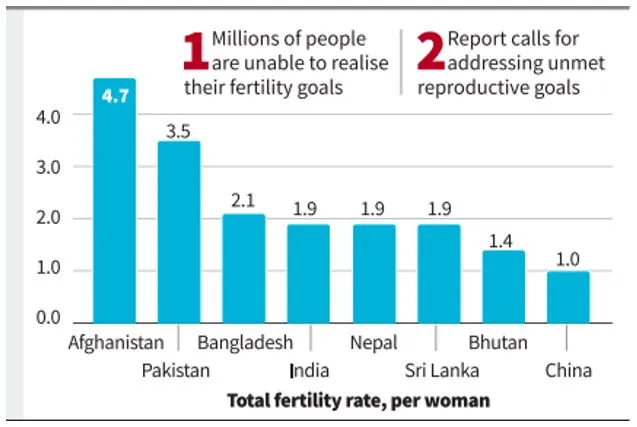

11th June 2025 (9 Topics)
Context
According to the United Nations Population Fund (UNFPA) State of the World Population 2025 Report, India’s population is estimated at 146.39 crore, with its Total Fertility Rate (TFR) declining to 1.9, below the replacement level of 2.1. The report projects India’s population to peak at 170 crore in the next 40 years, after which it is expected to decline.
India’s Demographic Trajectory and Socio-Economic Implications
India’s Population – Key Statistics
- Current Population (2025, UNFPA):39 crore (India), 141.61 crore (China)
- Fertility Rate (TFR):9 (Below replacement level of 2.1)
- Peak Projection: Population expected to reach 170 crore before declining in 40 years
- Working-age Population (15-64 years): 68% of total
- Youth Demographics (2025):
- Age 0–14: 24%
- Age 10–19: 17%
- Age 10–24: 26%
- Elderly Population (65+): 7%, projected to rise due to improved life expectancy
- Life Expectancy (2025):
- Men: 71 years
- Women: 74 years

Fertility Trends and the “Real” Fertility Crisis
- TFR at 1.9 reflects a shift towards smaller families and delayed childbirth.
- Replacement Level TFR is required to keep population size stable over generations (2.1).
- The UNFPA report calls attention to unmet fertility desires, labelling the mismatch between desired and actual childbearing as the "real fertility crisis."
- Advocates reproductive agency: free and informed choices about sex, contraception, and parenthood.
Implications of Falling Fertility Rates
- Demographic Dividend: With 68% of population in the working-age group, India is positioned to leverage this for economic growth.
- Ageing Population: The elderly population is projected to increase, demanding investment in geriatric care, pensions, and healthcare infrastructure.
- Urbanization & Migration: Urban areas may face increased pressure due to continued population growth in certain pockets, despite national fertility decline.
- Labour Force Dynamics: Lower fertility may eventually lead to a shrinking labour force, especially in states like Kerala, Tamil Nadu, and Delhi, which already have TFRs below 1.8.
Challenges with Delayed Census (2021–2027)
- The Census 2021, postponed to March 2027, results in a data vacuum.
- Accurate demographic policy formulation, welfare targeting, and health service delivery become difficult without decennial census data.
- Increased reliance on surveys and projections (like SRS, NFHS), which, although reliable, are no substitute for comprehensive enumeration.
Way Forward
- Strengthen Data Collection Mechanisms: Interim surveys like SRS, NFHS, and leveraging Aadhaar-linked service data can bridge the information gap until the next Census.
- Policy Shift from Population Control to Population Management: Focus should now be on healthy ageing, skilling of youth, gender equality, and urban infrastructure development.
- Support Reproductive Choices: Ensure access to quality contraception, maternal health, and comprehensive sexuality education.
- Promote Balanced Regional Development: Address regional disparities in fertility through targeted schemes like Mission Parivar Vikas in high TFR states.
Key Terms:Total Fertility Rate (TFR)
Demographic Dividend
Reproductive Agency
|
More Articles

